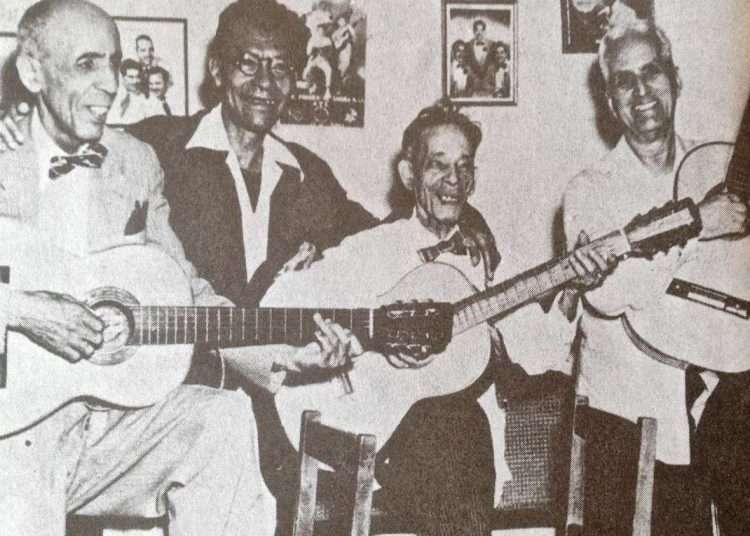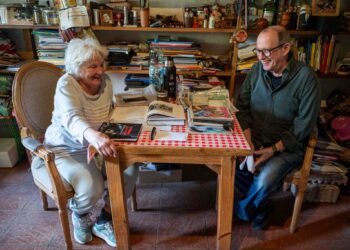In the midst of the baseball euphoria for the Cuban performance in the World Classic, another important cultural expression of the island has a well-deserved celebration this Sunday. The trova, consecrated just a few months ago as Intangible Heritage of the nation, today celebrates the day dedicated to its exponents. To the men and women who, with their guitar and voice, have contributed to the soul of Cuba for more than a century.
Every March 19, the Day of the Cuban Trovador is commemorated with all justice. The date pays homage to José “Pepe” Sánchez, that Santiago tailor who, without knowing musical writing, became a pioneer of trova music on the island and author of the first bolero: “Tristezas.” In his honor, an important festival is organized in Santiago de Cuba, which is already in its 60th edition and on this day pays tribute to him and the other singers who rest in the Santa Ifigenia cemetery, with concerts and other activities, such as the so-called “Trail of the trovadores.”
Pepe Sánchez illuminated a path that many have followed with their guitars up to the present day. And although the trova, like life, has logically evolved over time, and has also drawn on other sounds and influences, it still retains the connection with its founders. It maintains the creative breath and the bohemian spirit of those who went singing from bar to bar, from café to café and composed the same at sunset as at dawn, inspired by the captivating shine of some eyes, or the perfidy of some lips that treacherously wounded their hearts.
The traditional trova, that of Pepe Sánchez, his contemporaries and followers, is the germ of everything that would come later, currents and movements such as Filin, New Song Movement and Very New Song Movement. Without its poetic lyrics and evocative melodies, the rich tradition of Cuban songwriting, the work of relevant singer-songwriters such as César Portillo de la Luz, Martha Valdés, Silvio Rodríguez, Pablo Milanés and Noel Nicola, could not be understood.
Nor that of Lázaro García, Augusto Blanca, José Aquiles, Gerardo Alfonso and Santiago Feliú, among many others.
Taking advantage of the current baseball enthusiasm, and as a tribute to the Day of the Trovador, I propose to put together a Team Cuba of the traditional trova, a nine of essential figures from those early days who deserve to be forever at the altar of Cuban culture. I resist, however, the temptation to call them Team Asere, so as not to provoke the fury of the purists — although I suspect that many of those trovadores, town people, after all, would not mind the term —, and I appeal to a possible batting order, rather than supposed defensive positions, because I don’t imagine them waiting for the hits of others, but wood in hand, or better, guitar at the ready, connecting musical extra-base hits.
This is my lineup, but yours could very well be different.
1st bat: Due to his role as a precursor of the Cuban trova, the leading man in the lineup cannot be other than Pepe Sánchez himself (1856-1918). Born in the Los Hoyos neighborhood of Santiago, he promoted trova composition with his bolero “Tristezas” — also known as “Tristeza” or “Me entristeces, mujer” — and other works such as “Elvira,” “Cristinita,” “Rosa,” “Himno a Maceo” and “Cuba libre.” Even without musical training, he was also a guitarist, singer, promoter of gatherings and serenades, mentor to other trovadores and founder of several groups. Without him, the history of this genre and of Cuban music in general could not be written.
2nd bat: For this key turn in a lineup, I choose Rosendo Ruiz (1885-1983), also from Santiago. It is not for nothing that he is considered one of the four greats of traditional trova and one of the most prolific trovadores of his time. Among his many works are “Venganza de amor,” “Entre mares y arenas,” “Dos lindas rosas,” “Falso juramento,” “Redención” and “Te quiero así.” From beginning to play on a rustic palm-bark guitar, he became a teacher of that instrument and wrote a Método de estudios prácticos. In addition, he founded trios and quartets, and was the father of Rosendo Ruiz Quevedo, also a musician and composer.
3rd bat: In the turn that many assign to the best batter of a team, there is no other name than Gumersindo Garay (1867-1868). Since he is the ace of this nine-bat lineup, a genius who without knowing writing or music theory was able to compose more than 600 works and create harmonies that still amaze. Bohemian, joker, night owl, adventurer, his long life is enough for a novel and his music has assured posterity. No catalog of Cuban trova and song can do without creations such as “Perla Marina,” “Tardes grises,” “Amargas verdades,” “Retorna,” “Guarina” and “Mujer bayamesa.” His was a great average.
4th bat: If Sindo is the team’s third bat, then the fourth is Manuel Corona (1880-1950). This couple is the stuff of legend. Like Garay from Santiago, Corona from Las Villas has several of the most praised and popular works of traditional trova. His compositions with a woman’s name are particularly famous: “Mercedes,” “Aurora,” “Santa Cecilia” and, first and foremost, “Longina,” perhaps the longest home run of all the old trovadores. But to those hits we should add others such as “Doble inconsciencia” “Confesión a mi guitarra” and his also well-known musical responses to songs by other authors. A true slugger.
5th bat: To cover Corona’s back, no one better than the last of the four greats of traditional trova: Alberto Villalón (1882-1955). Born in Santiago de Cuba, he wrote his first song at the age of 14 and since then he composed hundreds of works. Unlike most trovadores, he could read music and had a good cultural background thanks to his well-off position. “La palma,” “Boda negra,” “A Martí,” “Me da miedo quererte” and “Yo reiré cuando tú llores,” are among his most popular songs. He was also a notorious guitarist and, as if that were not enough, he was among the founders of Ignacio Piñeiro’s Sexteto Nacional.
6th bat: If the eastern part of the island was the cradle of great trovadores, the center of Cuba is not far behind and there is Miguel Companioni (1881-1965) to prove it. The man born in Sancti Spíritus could well be the fourth player in this team due to his prolific life. He was a born hitter. He was not intimidated by losing his vision as a child and became an excellent guitarist, in addition to mastering other instruments. Among his works, which exceed 300, the classic “Mujer perjura” stands out, but to this we should add titles such as “La lira rota,” “Por qué latió mi corazón,” “Estrella matutina,” “Amelia” and “Esther.” Sancti Spíritus’ Casa de la Trova deservedly bears his name.
7th bat: From Sancti Spíritus is also Ángel Rafael Gómez (1889-1971), another who would well deserve a more prominent position in the lineup. If his name doesn’t ring a bell, don’t be surprised. No one knows him that way, except as “Teofilito,” the bard of “Pensamiento,” undoubtedly one of the greatest homers of traditional trova. His work, however, treasures many more titles of various genres, such as “Pienso en ti,” “Yo no sabía,” “Esfuerzos nulos” and “Si volvieras a mí.” He studied music as a child and learned to play various instruments. And he not only stood out as a trovador; he was part of the Municipal Band, founded a French brass band and directed Coros de Clave.
8th bat: In a world dominated by men, María Teresa Vera (1895-1965) shone in her own right. Her inclusion in this lineup does not seek to comply with gender quotas or anything similar, but to recognize one of the most notable trajectories of Cuban trova. She was a member of quartets, sextets and other groups, but it was her duets, particularly with Rafael Zequeira and Lorenzo Hierrezuelo, which established her in the trovador world. Extraordinary guitarist and singer, she defended with her voice songs by many authors and also hers, but none would achieve more fame than her immortal “Veinte años,” with lyrics by Guillermina Aramburo.
9th bat: Not for closing this lineup, the trovador imprint of Patricio Ballagas (1879-1920) is less. “El Camagüeyano,” as his friends used to call him in reference to the province he came from, is one of the leading figures of that time, and despite his early death, he left a recognizable mark on the way he composed and played the guitar. He formed part of duets, trios and other formations. He was one of the most celebrated guitarists of his time, and as a composer, he introduced countersinging or counterpoint to give greater prominence to the second voice. Among his works, “Timidez,” “Cuanto reniego,” “Yo te vi como las flores” and “El trovador” stand out.
No ball team is complete without a good bench, without guys who can pinch-hit at a crunch time or take the lead if the starters slump. And, fortunately, the traditional trova Team Cuba does not lack excellent hitters to wield the guitar at the right time.
At the risk of fueling the controversy, I am going to start this list with Miguel Matamoros (1894-1971). He is recognized more as a sonero, but that both as a composer and with his famous trio — together with the equally great Siro Rodríguez and Rafel Cueto — he deserved more than enough to even be included in the starting lineup. It is enough to hear themes of the poetry of “Juramento,” “Reclamo místico,” “Lágrimas negras” and “Mariposita de primavera,” to immediately send him to the batting box.
But Don Miguel will not be alone in the dugout. In order not to make the list too long, I am going to leave at five the names that will keep the famous author of “Son de la loma” and “Dulce embeleso” company. In no order of distinction, I then sit at his side Eusebio Delfín (1893-1965) from Cienfuegos. Composer of that classic that is “¿Y tú qué has hecho?” — also known as “En el tronco de un árbol.” And Havana’s Oscar Hernández (1891-1967), Corona’s partner, to whom we owe two indisputable hits of the trova: “Ella y yo” and “Rosa roja.”
Also Emiliano Blez (1879-1973) from Santiago, “El Decano,” a disciple of Pepe Sánchez and a great friend of Sindo, with whom he performed on many occasions. Blez was the author of songs such as “Amoroso idilio,” “Corazón de fuego” and “Dueña eres, mujer, de mis amores.” As well as his countryman Salvador Adams (1894-1971), who played with Matamoros himself and other greats of yesteryear. Adams left such significant titles as “Sublime Illusion” for posterity.
Finally, the least known but no less important José “Pepe” Figarola (1893-1977), for many the best primo singer of the traditional Santiago trova, who joined groups with Pepe Sánchez and Emiliano Blez, among other trovadores, and in whose voice songs by these and other authors became popular, as well as his own, such as “Un beso en el alma.”










